QUESTIONS AND ITS ANSWERS OF NURSING ASSIGNMENT
VerifiedAdded on 2022/08/17
|12
|3162
|12
AI Summary
Contribute Materials
Your contribution can guide someone’s learning journey. Share your
documents today.
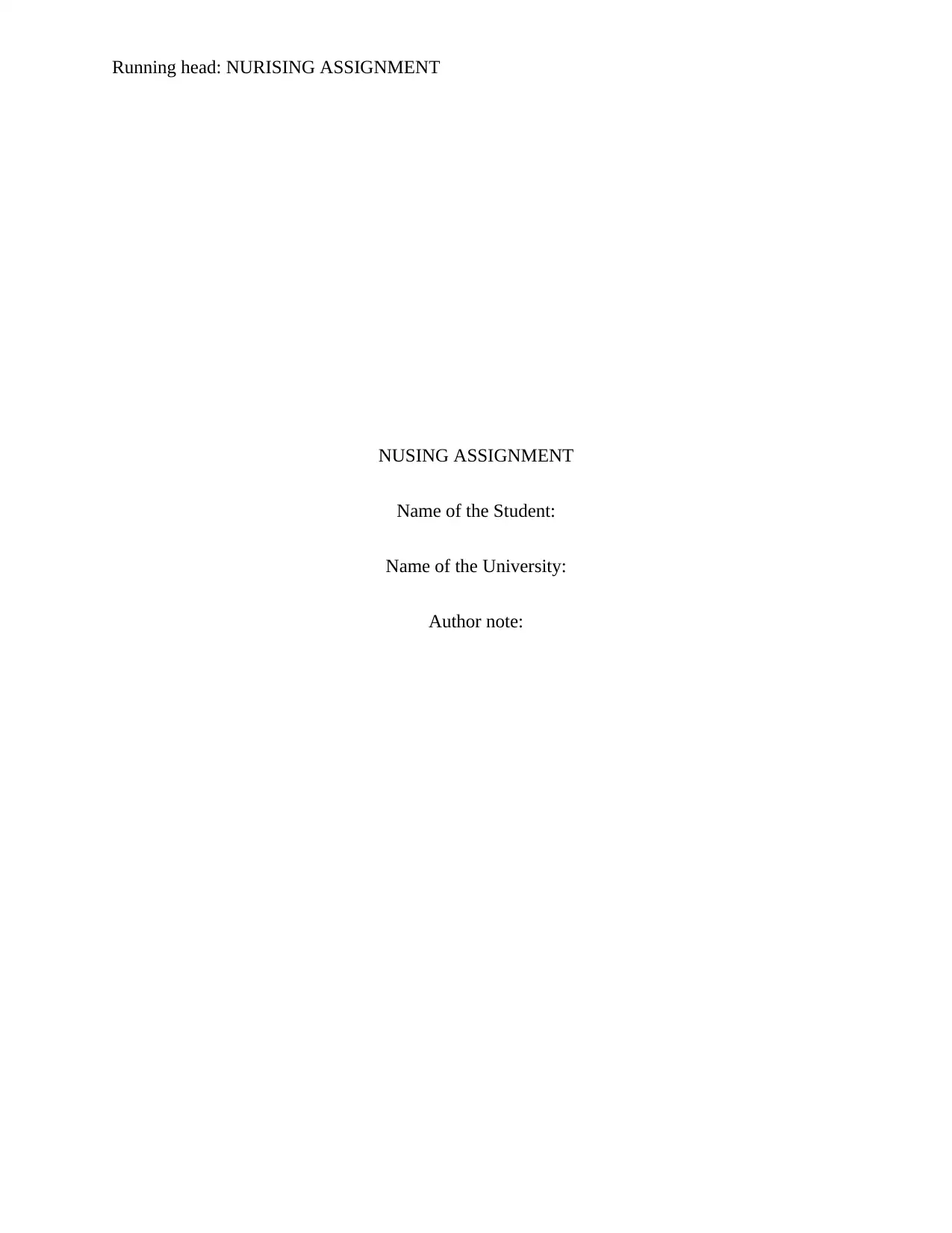
Running head: NURISING ASSIGNMENT
NUSING ASSIGNMENT
Name of the Student:
Name of the University:
Author note:
NUSING ASSIGNMENT
Name of the Student:
Name of the University:
Author note:
Secure Best Marks with AI Grader
Need help grading? Try our AI Grader for instant feedback on your assignments.
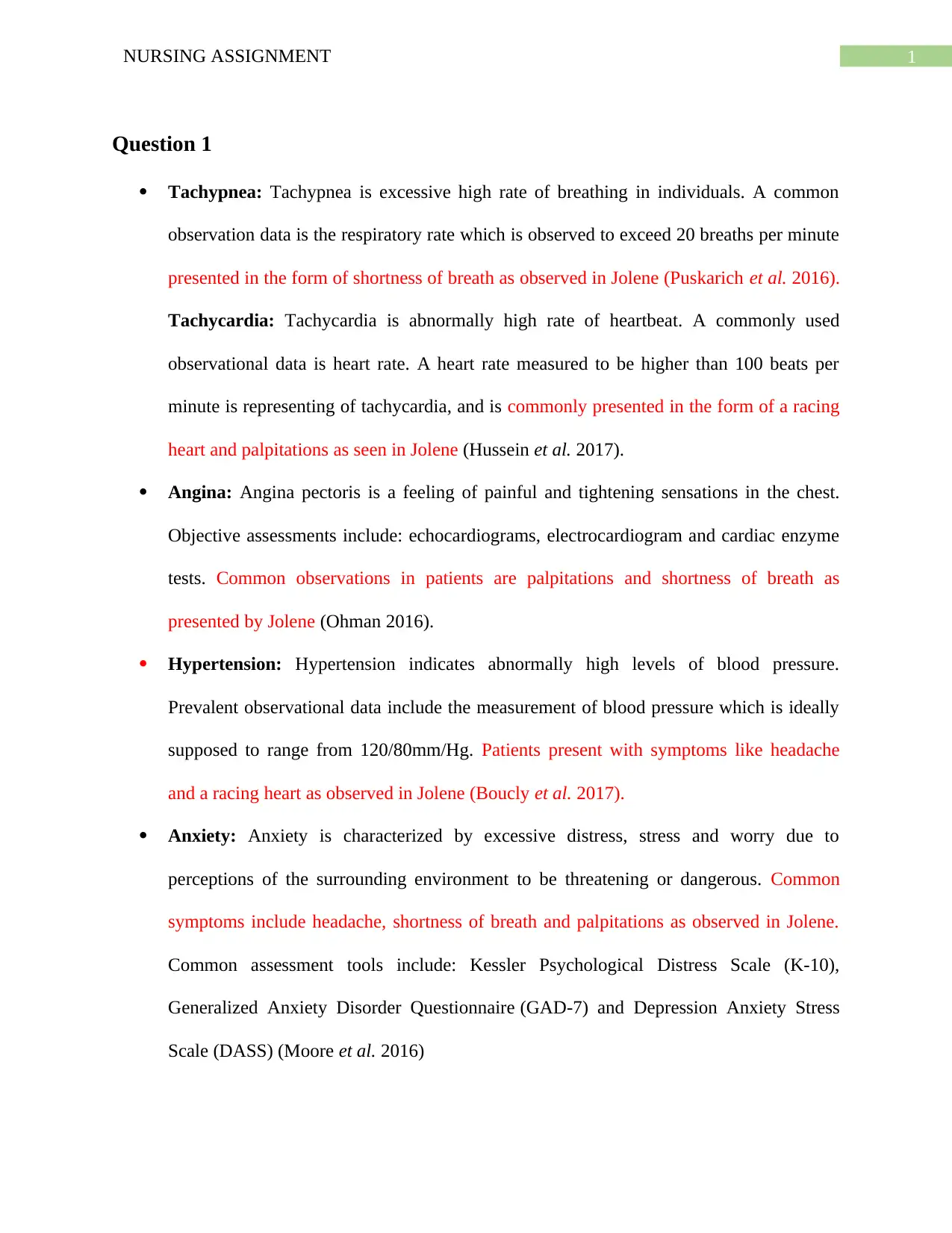
1NURSING ASSIGNMENT
Question 1
Tachypnea: Tachypnea is excessive high rate of breathing in individuals. A common
observation data is the respiratory rate which is observed to exceed 20 breaths per minute
presented in the form of shortness of breath as observed in Jolene (Puskarich et al. 2016).
Tachycardia: Tachycardia is abnormally high rate of heartbeat. A commonly used
observational data is heart rate. A heart rate measured to be higher than 100 beats per
minute is representing of tachycardia, and is commonly presented in the form of a racing
heart and palpitations as seen in Jolene (Hussein et al. 2017).
Angina: Angina pectoris is a feeling of painful and tightening sensations in the chest.
Objective assessments include: echocardiograms, electrocardiogram and cardiac enzyme
tests. Common observations in patients are palpitations and shortness of breath as
presented by Jolene (Ohman 2016).
Hypertension: Hypertension indicates abnormally high levels of blood pressure.
Prevalent observational data include the measurement of blood pressure which is ideally
supposed to range from 120/80mm/Hg. Patients present with symptoms like headache
and a racing heart as observed in Jolene (Boucly et al. 2017).
Anxiety: Anxiety is characterized by excessive distress, stress and worry due to
perceptions of the surrounding environment to be threatening or dangerous. Common
symptoms include headache, shortness of breath and palpitations as observed in Jolene.
Common assessment tools include: Kessler Psychological Distress Scale (K-10),
Generalized Anxiety Disorder Questionnaire (GAD-7) and Depression Anxiety Stress
Scale (DASS) (Moore et al. 2016)
Question 1
Tachypnea: Tachypnea is excessive high rate of breathing in individuals. A common
observation data is the respiratory rate which is observed to exceed 20 breaths per minute
presented in the form of shortness of breath as observed in Jolene (Puskarich et al. 2016).
Tachycardia: Tachycardia is abnormally high rate of heartbeat. A commonly used
observational data is heart rate. A heart rate measured to be higher than 100 beats per
minute is representing of tachycardia, and is commonly presented in the form of a racing
heart and palpitations as seen in Jolene (Hussein et al. 2017).
Angina: Angina pectoris is a feeling of painful and tightening sensations in the chest.
Objective assessments include: echocardiograms, electrocardiogram and cardiac enzyme
tests. Common observations in patients are palpitations and shortness of breath as
presented by Jolene (Ohman 2016).
Hypertension: Hypertension indicates abnormally high levels of blood pressure.
Prevalent observational data include the measurement of blood pressure which is ideally
supposed to range from 120/80mm/Hg. Patients present with symptoms like headache
and a racing heart as observed in Jolene (Boucly et al. 2017).
Anxiety: Anxiety is characterized by excessive distress, stress and worry due to
perceptions of the surrounding environment to be threatening or dangerous. Common
symptoms include headache, shortness of breath and palpitations as observed in Jolene.
Common assessment tools include: Kessler Psychological Distress Scale (K-10),
Generalized Anxiety Disorder Questionnaire (GAD-7) and Depression Anxiety Stress
Scale (DASS) (Moore et al. 2016)
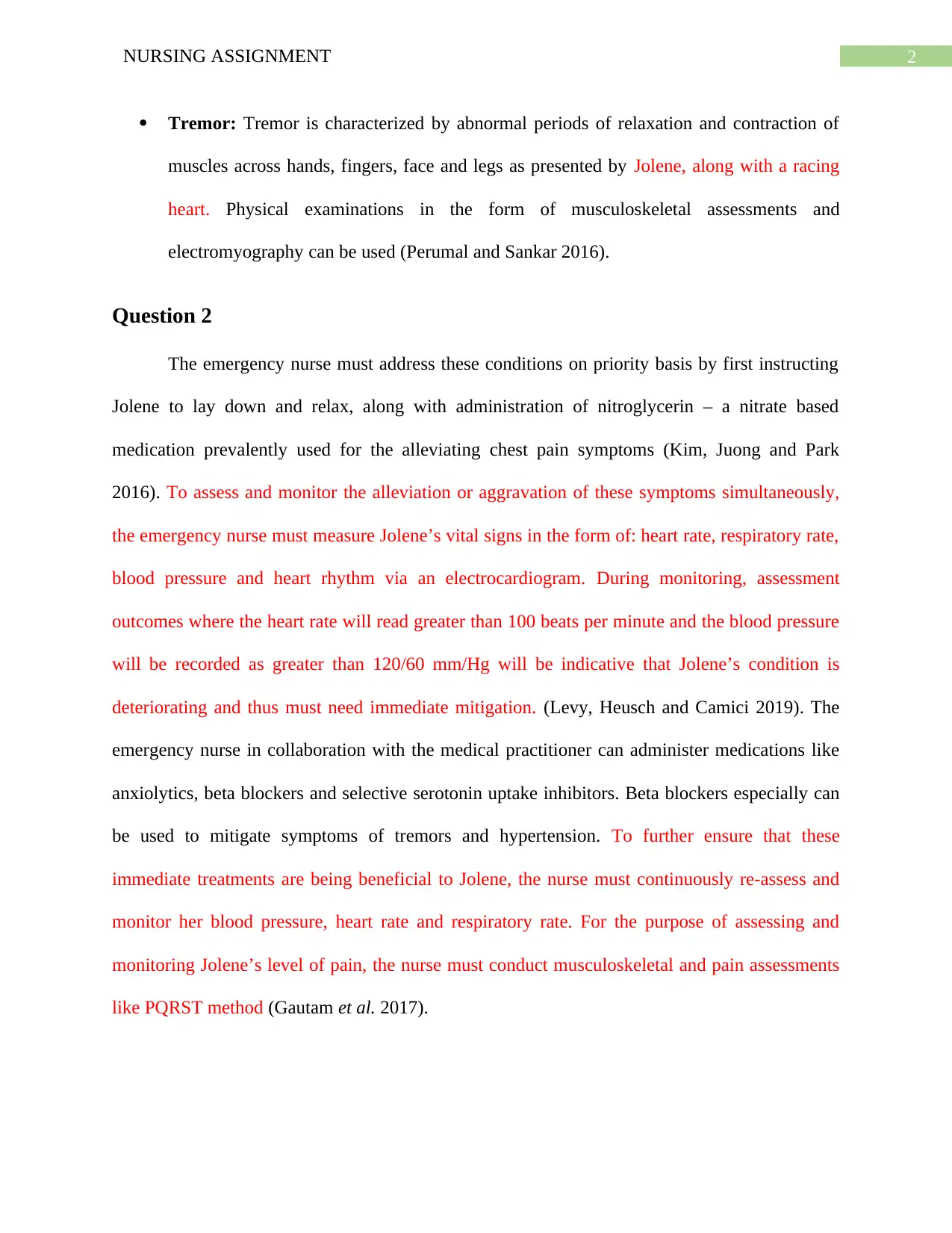
2NURSING ASSIGNMENT
Tremor: Tremor is characterized by abnormal periods of relaxation and contraction of
muscles across hands, fingers, face and legs as presented by Jolene, along with a racing
heart. Physical examinations in the form of musculoskeletal assessments and
electromyography can be used (Perumal and Sankar 2016).
Question 2
The emergency nurse must address these conditions on priority basis by first instructing
Jolene to lay down and relax, along with administration of nitroglycerin – a nitrate based
medication prevalently used for the alleviating chest pain symptoms (Kim, Juong and Park
2016). To assess and monitor the alleviation or aggravation of these symptoms simultaneously,
the emergency nurse must measure Jolene’s vital signs in the form of: heart rate, respiratory rate,
blood pressure and heart rhythm via an electrocardiogram. During monitoring, assessment
outcomes where the heart rate will read greater than 100 beats per minute and the blood pressure
will be recorded as greater than 120/60 mm/Hg will be indicative that Jolene’s condition is
deteriorating and thus must need immediate mitigation. (Levy, Heusch and Camici 2019). The
emergency nurse in collaboration with the medical practitioner can administer medications like
anxiolytics, beta blockers and selective serotonin uptake inhibitors. Beta blockers especially can
be used to mitigate symptoms of tremors and hypertension. To further ensure that these
immediate treatments are being beneficial to Jolene, the nurse must continuously re-assess and
monitor her blood pressure, heart rate and respiratory rate. For the purpose of assessing and
monitoring Jolene’s level of pain, the nurse must conduct musculoskeletal and pain assessments
like PQRST method (Gautam et al. 2017).
Tremor: Tremor is characterized by abnormal periods of relaxation and contraction of
muscles across hands, fingers, face and legs as presented by Jolene, along with a racing
heart. Physical examinations in the form of musculoskeletal assessments and
electromyography can be used (Perumal and Sankar 2016).
Question 2
The emergency nurse must address these conditions on priority basis by first instructing
Jolene to lay down and relax, along with administration of nitroglycerin – a nitrate based
medication prevalently used for the alleviating chest pain symptoms (Kim, Juong and Park
2016). To assess and monitor the alleviation or aggravation of these symptoms simultaneously,
the emergency nurse must measure Jolene’s vital signs in the form of: heart rate, respiratory rate,
blood pressure and heart rhythm via an electrocardiogram. During monitoring, assessment
outcomes where the heart rate will read greater than 100 beats per minute and the blood pressure
will be recorded as greater than 120/60 mm/Hg will be indicative that Jolene’s condition is
deteriorating and thus must need immediate mitigation. (Levy, Heusch and Camici 2019). The
emergency nurse in collaboration with the medical practitioner can administer medications like
anxiolytics, beta blockers and selective serotonin uptake inhibitors. Beta blockers especially can
be used to mitigate symptoms of tremors and hypertension. To further ensure that these
immediate treatments are being beneficial to Jolene, the nurse must continuously re-assess and
monitor her blood pressure, heart rate and respiratory rate. For the purpose of assessing and
monitoring Jolene’s level of pain, the nurse must conduct musculoskeletal and pain assessments
like PQRST method (Gautam et al. 2017).
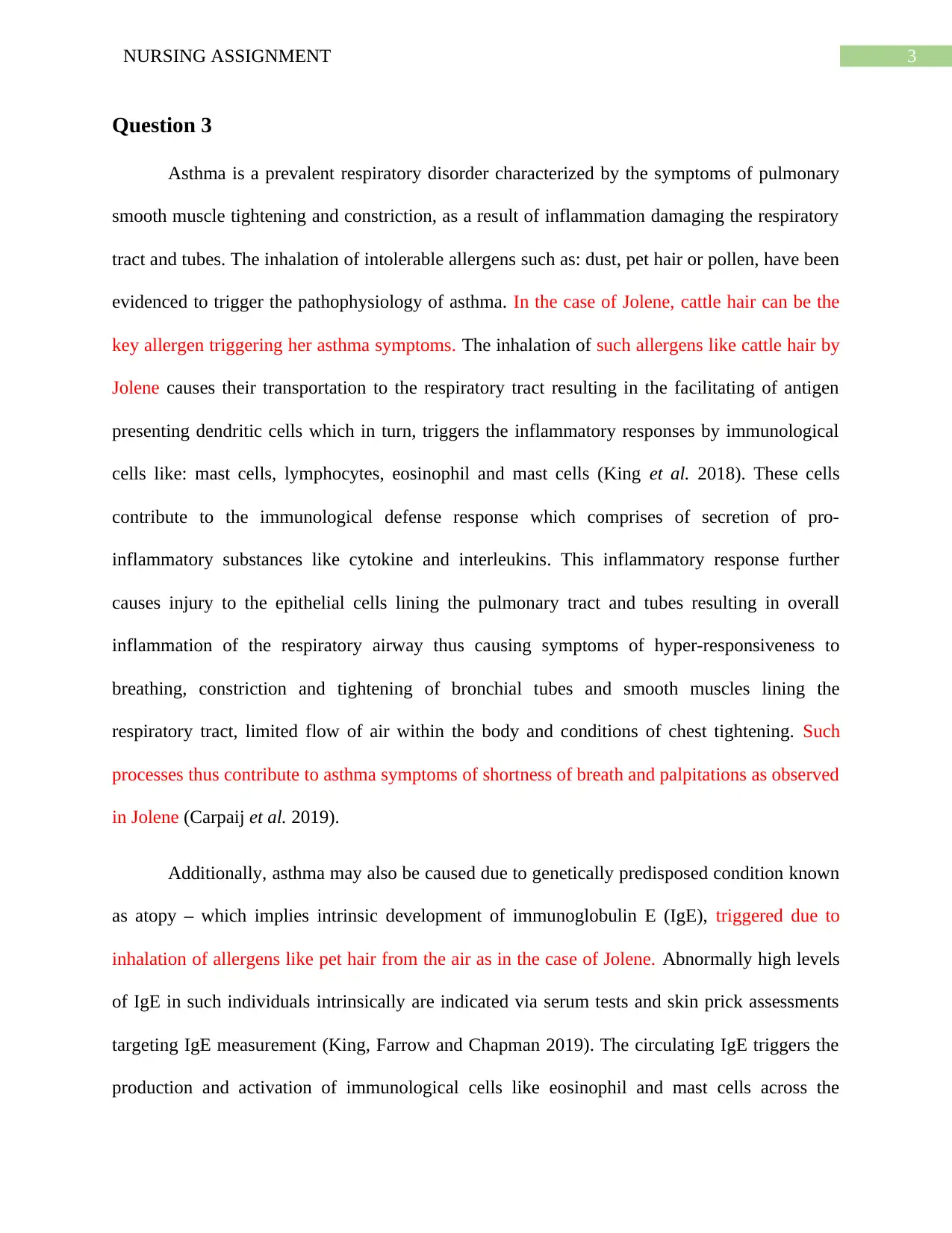
3NURSING ASSIGNMENT
Question 3
Asthma is a prevalent respiratory disorder characterized by the symptoms of pulmonary
smooth muscle tightening and constriction, as a result of inflammation damaging the respiratory
tract and tubes. The inhalation of intolerable allergens such as: dust, pet hair or pollen, have been
evidenced to trigger the pathophysiology of asthma. In the case of Jolene, cattle hair can be the
key allergen triggering her asthma symptoms. The inhalation of such allergens like cattle hair by
Jolene causes their transportation to the respiratory tract resulting in the facilitating of antigen
presenting dendritic cells which in turn, triggers the inflammatory responses by immunological
cells like: mast cells, lymphocytes, eosinophil and mast cells (King et al. 2018). These cells
contribute to the immunological defense response which comprises of secretion of pro-
inflammatory substances like cytokine and interleukins. This inflammatory response further
causes injury to the epithelial cells lining the pulmonary tract and tubes resulting in overall
inflammation of the respiratory airway thus causing symptoms of hyper-responsiveness to
breathing, constriction and tightening of bronchial tubes and smooth muscles lining the
respiratory tract, limited flow of air within the body and conditions of chest tightening. Such
processes thus contribute to asthma symptoms of shortness of breath and palpitations as observed
in Jolene (Carpaij et al. 2019).
Additionally, asthma may also be caused due to genetically predisposed condition known
as atopy – which implies intrinsic development of immunoglobulin E (IgE), triggered due to
inhalation of allergens like pet hair from the air as in the case of Jolene. Abnormally high levels
of IgE in such individuals intrinsically are indicated via serum tests and skin prick assessments
targeting IgE measurement (King, Farrow and Chapman 2019). The circulating IgE triggers the
production and activation of immunological cells like eosinophil and mast cells across the
Question 3
Asthma is a prevalent respiratory disorder characterized by the symptoms of pulmonary
smooth muscle tightening and constriction, as a result of inflammation damaging the respiratory
tract and tubes. The inhalation of intolerable allergens such as: dust, pet hair or pollen, have been
evidenced to trigger the pathophysiology of asthma. In the case of Jolene, cattle hair can be the
key allergen triggering her asthma symptoms. The inhalation of such allergens like cattle hair by
Jolene causes their transportation to the respiratory tract resulting in the facilitating of antigen
presenting dendritic cells which in turn, triggers the inflammatory responses by immunological
cells like: mast cells, lymphocytes, eosinophil and mast cells (King et al. 2018). These cells
contribute to the immunological defense response which comprises of secretion of pro-
inflammatory substances like cytokine and interleukins. This inflammatory response further
causes injury to the epithelial cells lining the pulmonary tract and tubes resulting in overall
inflammation of the respiratory airway thus causing symptoms of hyper-responsiveness to
breathing, constriction and tightening of bronchial tubes and smooth muscles lining the
respiratory tract, limited flow of air within the body and conditions of chest tightening. Such
processes thus contribute to asthma symptoms of shortness of breath and palpitations as observed
in Jolene (Carpaij et al. 2019).
Additionally, asthma may also be caused due to genetically predisposed condition known
as atopy – which implies intrinsic development of immunoglobulin E (IgE), triggered due to
inhalation of allergens like pet hair from the air as in the case of Jolene. Abnormally high levels
of IgE in such individuals intrinsically are indicated via serum tests and skin prick assessments
targeting IgE measurement (King, Farrow and Chapman 2019). The circulating IgE triggers the
production and activation of immunological cells like eosinophil and mast cells across the
Secure Best Marks with AI Grader
Need help grading? Try our AI Grader for instant feedback on your assignments.
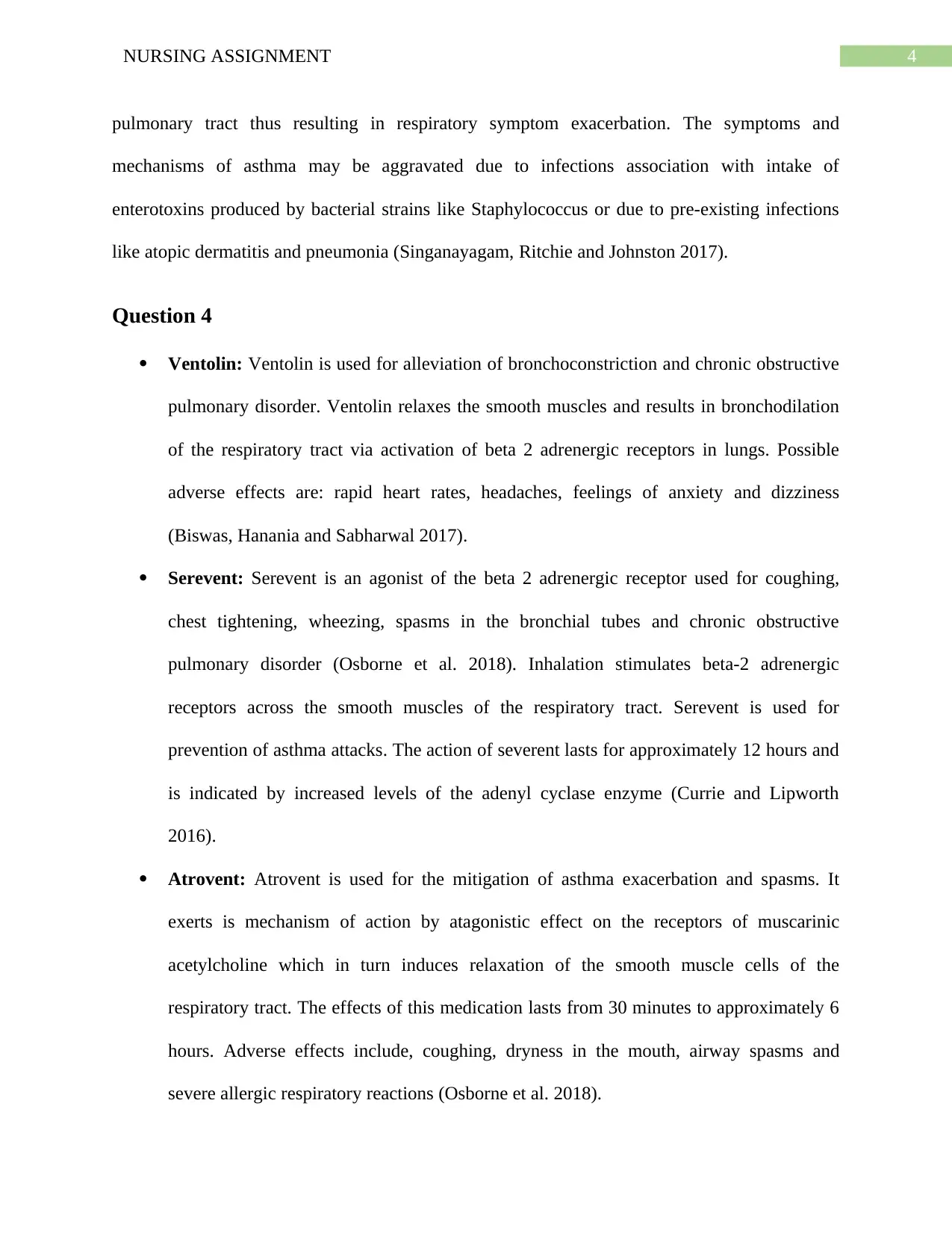
4NURSING ASSIGNMENT
pulmonary tract thus resulting in respiratory symptom exacerbation. The symptoms and
mechanisms of asthma may be aggravated due to infections association with intake of
enterotoxins produced by bacterial strains like Staphylococcus or due to pre-existing infections
like atopic dermatitis and pneumonia (Singanayagam, Ritchie and Johnston 2017).
Question 4
Ventolin: Ventolin is used for alleviation of bronchoconstriction and chronic obstructive
pulmonary disorder. Ventolin relaxes the smooth muscles and results in bronchodilation
of the respiratory tract via activation of beta 2 adrenergic receptors in lungs. Possible
adverse effects are: rapid heart rates, headaches, feelings of anxiety and dizziness
(Biswas, Hanania and Sabharwal 2017).
Serevent: Serevent is an agonist of the beta 2 adrenergic receptor used for coughing,
chest tightening, wheezing, spasms in the bronchial tubes and chronic obstructive
pulmonary disorder (Osborne et al. 2018). Inhalation stimulates beta-2 adrenergic
receptors across the smooth muscles of the respiratory tract. Serevent is used for
prevention of asthma attacks. The action of severent lasts for approximately 12 hours and
is indicated by increased levels of the adenyl cyclase enzyme (Currie and Lipworth
2016).
Atrovent: Atrovent is used for the mitigation of asthma exacerbation and spasms. It
exerts is mechanism of action by atagonistic effect on the receptors of muscarinic
acetylcholine which in turn induces relaxation of the smooth muscle cells of the
respiratory tract. The effects of this medication lasts from 30 minutes to approximately 6
hours. Adverse effects include, coughing, dryness in the mouth, airway spasms and
severe allergic respiratory reactions (Osborne et al. 2018).
pulmonary tract thus resulting in respiratory symptom exacerbation. The symptoms and
mechanisms of asthma may be aggravated due to infections association with intake of
enterotoxins produced by bacterial strains like Staphylococcus or due to pre-existing infections
like atopic dermatitis and pneumonia (Singanayagam, Ritchie and Johnston 2017).
Question 4
Ventolin: Ventolin is used for alleviation of bronchoconstriction and chronic obstructive
pulmonary disorder. Ventolin relaxes the smooth muscles and results in bronchodilation
of the respiratory tract via activation of beta 2 adrenergic receptors in lungs. Possible
adverse effects are: rapid heart rates, headaches, feelings of anxiety and dizziness
(Biswas, Hanania and Sabharwal 2017).
Serevent: Serevent is an agonist of the beta 2 adrenergic receptor used for coughing,
chest tightening, wheezing, spasms in the bronchial tubes and chronic obstructive
pulmonary disorder (Osborne et al. 2018). Inhalation stimulates beta-2 adrenergic
receptors across the smooth muscles of the respiratory tract. Serevent is used for
prevention of asthma attacks. The action of severent lasts for approximately 12 hours and
is indicated by increased levels of the adenyl cyclase enzyme (Currie and Lipworth
2016).
Atrovent: Atrovent is used for the mitigation of asthma exacerbation and spasms. It
exerts is mechanism of action by atagonistic effect on the receptors of muscarinic
acetylcholine which in turn induces relaxation of the smooth muscle cells of the
respiratory tract. The effects of this medication lasts from 30 minutes to approximately 6
hours. Adverse effects include, coughing, dryness in the mouth, airway spasms and
severe allergic respiratory reactions (Osborne et al. 2018).
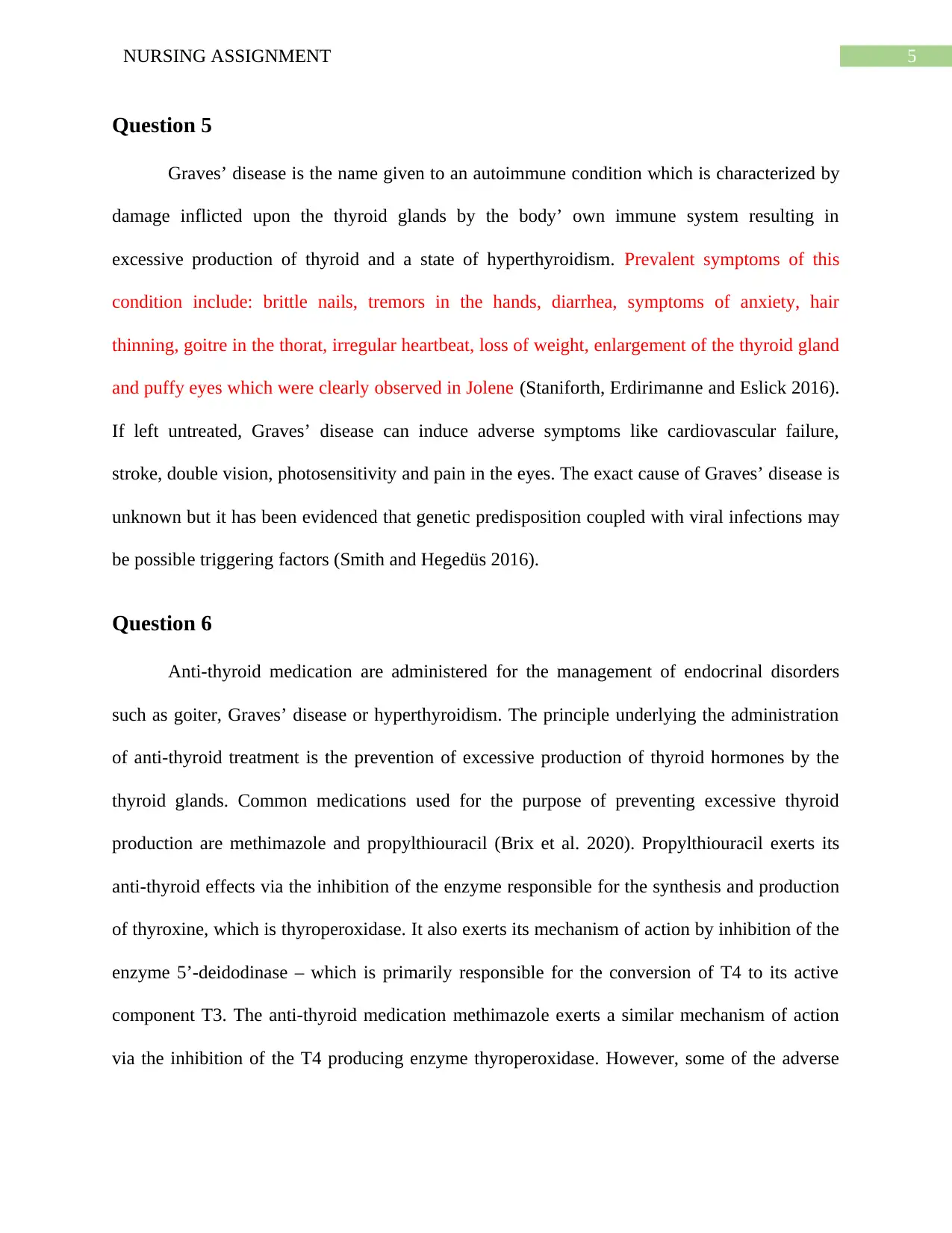
5NURSING ASSIGNMENT
Question 5
Graves’ disease is the name given to an autoimmune condition which is characterized by
damage inflicted upon the thyroid glands by the body’ own immune system resulting in
excessive production of thyroid and a state of hyperthyroidism. Prevalent symptoms of this
condition include: brittle nails, tremors in the hands, diarrhea, symptoms of anxiety, hair
thinning, goitre in the thorat, irregular heartbeat, loss of weight, enlargement of the thyroid gland
and puffy eyes which were clearly observed in Jolene (Staniforth, Erdirimanne and Eslick 2016).
If left untreated, Graves’ disease can induce adverse symptoms like cardiovascular failure,
stroke, double vision, photosensitivity and pain in the eyes. The exact cause of Graves’ disease is
unknown but it has been evidenced that genetic predisposition coupled with viral infections may
be possible triggering factors (Smith and Hegedüs 2016).
Question 6
Anti-thyroid medication are administered for the management of endocrinal disorders
such as goiter, Graves’ disease or hyperthyroidism. The principle underlying the administration
of anti-thyroid treatment is the prevention of excessive production of thyroid hormones by the
thyroid glands. Common medications used for the purpose of preventing excessive thyroid
production are methimazole and propylthiouracil (Brix et al. 2020). Propylthiouracil exerts its
anti-thyroid effects via the inhibition of the enzyme responsible for the synthesis and production
of thyroxine, which is thyroperoxidase. It also exerts its mechanism of action by inhibition of the
enzyme 5’-deidodinase – which is primarily responsible for the conversion of T4 to its active
component T3. The anti-thyroid medication methimazole exerts a similar mechanism of action
via the inhibition of the T4 producing enzyme thyroperoxidase. However, some of the adverse
Question 5
Graves’ disease is the name given to an autoimmune condition which is characterized by
damage inflicted upon the thyroid glands by the body’ own immune system resulting in
excessive production of thyroid and a state of hyperthyroidism. Prevalent symptoms of this
condition include: brittle nails, tremors in the hands, diarrhea, symptoms of anxiety, hair
thinning, goitre in the thorat, irregular heartbeat, loss of weight, enlargement of the thyroid gland
and puffy eyes which were clearly observed in Jolene (Staniforth, Erdirimanne and Eslick 2016).
If left untreated, Graves’ disease can induce adverse symptoms like cardiovascular failure,
stroke, double vision, photosensitivity and pain in the eyes. The exact cause of Graves’ disease is
unknown but it has been evidenced that genetic predisposition coupled with viral infections may
be possible triggering factors (Smith and Hegedüs 2016).
Question 6
Anti-thyroid medication are administered for the management of endocrinal disorders
such as goiter, Graves’ disease or hyperthyroidism. The principle underlying the administration
of anti-thyroid treatment is the prevention of excessive production of thyroid hormones by the
thyroid glands. Common medications used for the purpose of preventing excessive thyroid
production are methimazole and propylthiouracil (Brix et al. 2020). Propylthiouracil exerts its
anti-thyroid effects via the inhibition of the enzyme responsible for the synthesis and production
of thyroxine, which is thyroperoxidase. It also exerts its mechanism of action by inhibition of the
enzyme 5’-deidodinase – which is primarily responsible for the conversion of T4 to its active
component T3. The anti-thyroid medication methimazole exerts a similar mechanism of action
via the inhibition of the T4 producing enzyme thyroperoxidase. However, some of the adverse
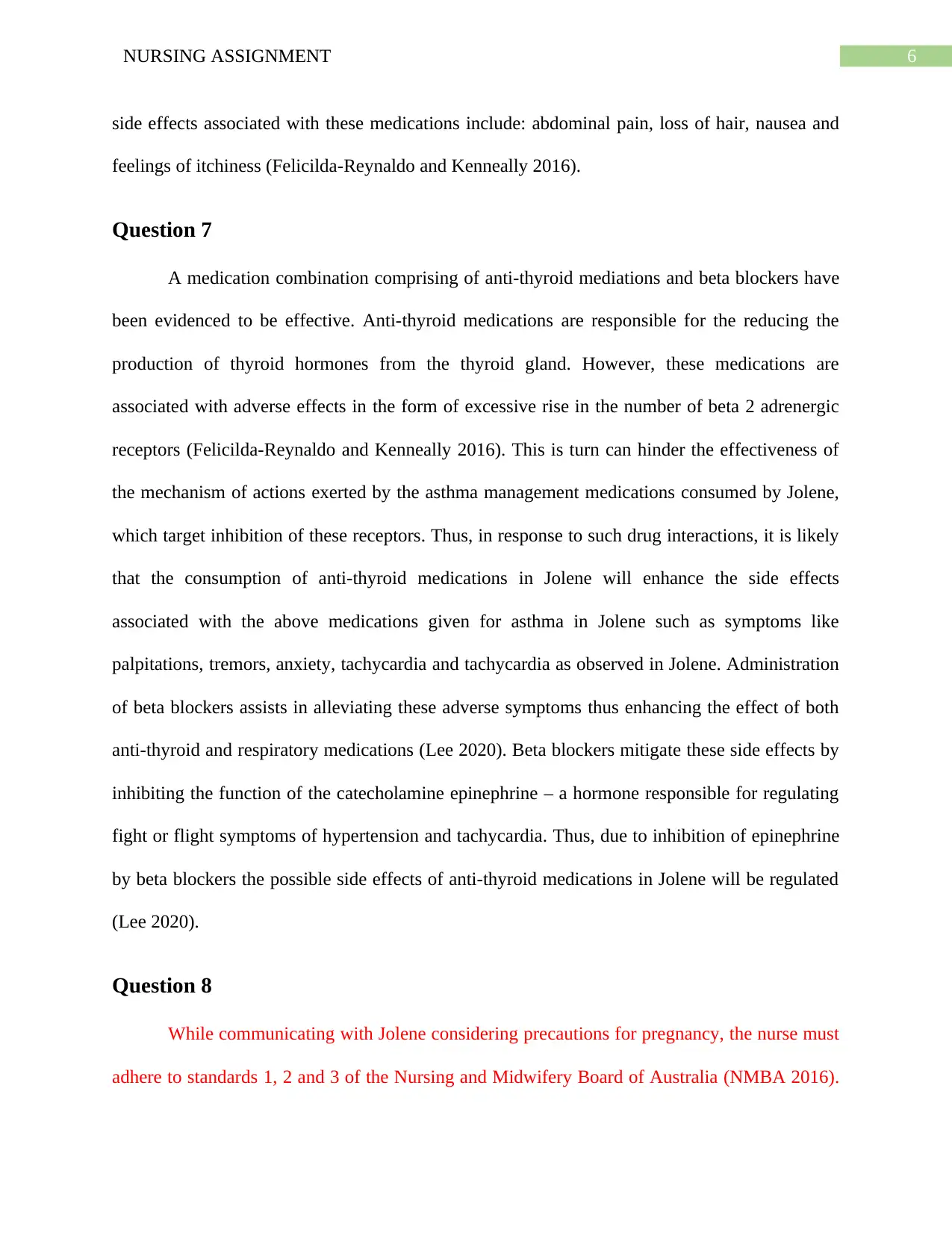
6NURSING ASSIGNMENT
side effects associated with these medications include: abdominal pain, loss of hair, nausea and
feelings of itchiness (Felicilda-Reynaldo and Kenneally 2016).
Question 7
A medication combination comprising of anti-thyroid mediations and beta blockers have
been evidenced to be effective. Anti-thyroid medications are responsible for the reducing the
production of thyroid hormones from the thyroid gland. However, these medications are
associated with adverse effects in the form of excessive rise in the number of beta 2 adrenergic
receptors (Felicilda-Reynaldo and Kenneally 2016). This is turn can hinder the effectiveness of
the mechanism of actions exerted by the asthma management medications consumed by Jolene,
which target inhibition of these receptors. Thus, in response to such drug interactions, it is likely
that the consumption of anti-thyroid medications in Jolene will enhance the side effects
associated with the above medications given for asthma in Jolene such as symptoms like
palpitations, tremors, anxiety, tachycardia and tachycardia as observed in Jolene. Administration
of beta blockers assists in alleviating these adverse symptoms thus enhancing the effect of both
anti-thyroid and respiratory medications (Lee 2020). Beta blockers mitigate these side effects by
inhibiting the function of the catecholamine epinephrine – a hormone responsible for regulating
fight or flight symptoms of hypertension and tachycardia. Thus, due to inhibition of epinephrine
by beta blockers the possible side effects of anti-thyroid medications in Jolene will be regulated
(Lee 2020).
Question 8
While communicating with Jolene considering precautions for pregnancy, the nurse must
adhere to standards 1, 2 and 3 of the Nursing and Midwifery Board of Australia (NMBA 2016).
side effects associated with these medications include: abdominal pain, loss of hair, nausea and
feelings of itchiness (Felicilda-Reynaldo and Kenneally 2016).
Question 7
A medication combination comprising of anti-thyroid mediations and beta blockers have
been evidenced to be effective. Anti-thyroid medications are responsible for the reducing the
production of thyroid hormones from the thyroid gland. However, these medications are
associated with adverse effects in the form of excessive rise in the number of beta 2 adrenergic
receptors (Felicilda-Reynaldo and Kenneally 2016). This is turn can hinder the effectiveness of
the mechanism of actions exerted by the asthma management medications consumed by Jolene,
which target inhibition of these receptors. Thus, in response to such drug interactions, it is likely
that the consumption of anti-thyroid medications in Jolene will enhance the side effects
associated with the above medications given for asthma in Jolene such as symptoms like
palpitations, tremors, anxiety, tachycardia and tachycardia as observed in Jolene. Administration
of beta blockers assists in alleviating these adverse symptoms thus enhancing the effect of both
anti-thyroid and respiratory medications (Lee 2020). Beta blockers mitigate these side effects by
inhibiting the function of the catecholamine epinephrine – a hormone responsible for regulating
fight or flight symptoms of hypertension and tachycardia. Thus, due to inhibition of epinephrine
by beta blockers the possible side effects of anti-thyroid medications in Jolene will be regulated
(Lee 2020).
Question 8
While communicating with Jolene considering precautions for pregnancy, the nurse must
adhere to standards 1, 2 and 3 of the Nursing and Midwifery Board of Australia (NMBA 2016).
Paraphrase This Document
Need a fresh take? Get an instant paraphrase of this document with our AI Paraphraser
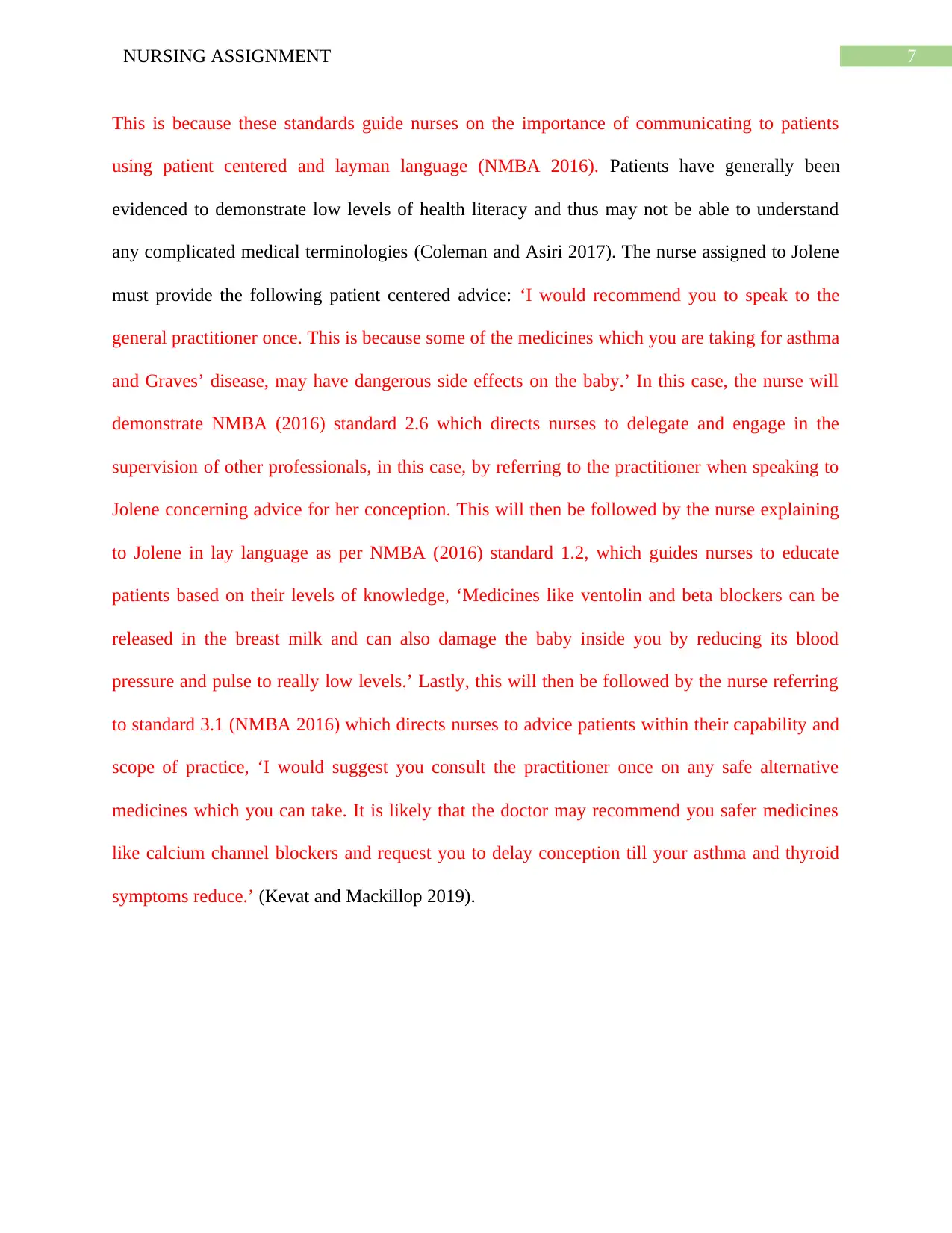
7NURSING ASSIGNMENT
This is because these standards guide nurses on the importance of communicating to patients
using patient centered and layman language (NMBA 2016). Patients have generally been
evidenced to demonstrate low levels of health literacy and thus may not be able to understand
any complicated medical terminologies (Coleman and Asiri 2017). The nurse assigned to Jolene
must provide the following patient centered advice: ‘I would recommend you to speak to the
general practitioner once. This is because some of the medicines which you are taking for asthma
and Graves’ disease, may have dangerous side effects on the baby.’ In this case, the nurse will
demonstrate NMBA (2016) standard 2.6 which directs nurses to delegate and engage in the
supervision of other professionals, in this case, by referring to the practitioner when speaking to
Jolene concerning advice for her conception. This will then be followed by the nurse explaining
to Jolene in lay language as per NMBA (2016) standard 1.2, which guides nurses to educate
patients based on their levels of knowledge, ‘Medicines like ventolin and beta blockers can be
released in the breast milk and can also damage the baby inside you by reducing its blood
pressure and pulse to really low levels.’ Lastly, this will then be followed by the nurse referring
to standard 3.1 (NMBA 2016) which directs nurses to advice patients within their capability and
scope of practice, ‘I would suggest you consult the practitioner once on any safe alternative
medicines which you can take. It is likely that the doctor may recommend you safer medicines
like calcium channel blockers and request you to delay conception till your asthma and thyroid
symptoms reduce.’ (Kevat and Mackillop 2019).
This is because these standards guide nurses on the importance of communicating to patients
using patient centered and layman language (NMBA 2016). Patients have generally been
evidenced to demonstrate low levels of health literacy and thus may not be able to understand
any complicated medical terminologies (Coleman and Asiri 2017). The nurse assigned to Jolene
must provide the following patient centered advice: ‘I would recommend you to speak to the
general practitioner once. This is because some of the medicines which you are taking for asthma
and Graves’ disease, may have dangerous side effects on the baby.’ In this case, the nurse will
demonstrate NMBA (2016) standard 2.6 which directs nurses to delegate and engage in the
supervision of other professionals, in this case, by referring to the practitioner when speaking to
Jolene concerning advice for her conception. This will then be followed by the nurse explaining
to Jolene in lay language as per NMBA (2016) standard 1.2, which guides nurses to educate
patients based on their levels of knowledge, ‘Medicines like ventolin and beta blockers can be
released in the breast milk and can also damage the baby inside you by reducing its blood
pressure and pulse to really low levels.’ Lastly, this will then be followed by the nurse referring
to standard 3.1 (NMBA 2016) which directs nurses to advice patients within their capability and
scope of practice, ‘I would suggest you consult the practitioner once on any safe alternative
medicines which you can take. It is likely that the doctor may recommend you safer medicines
like calcium channel blockers and request you to delay conception till your asthma and thyroid
symptoms reduce.’ (Kevat and Mackillop 2019).
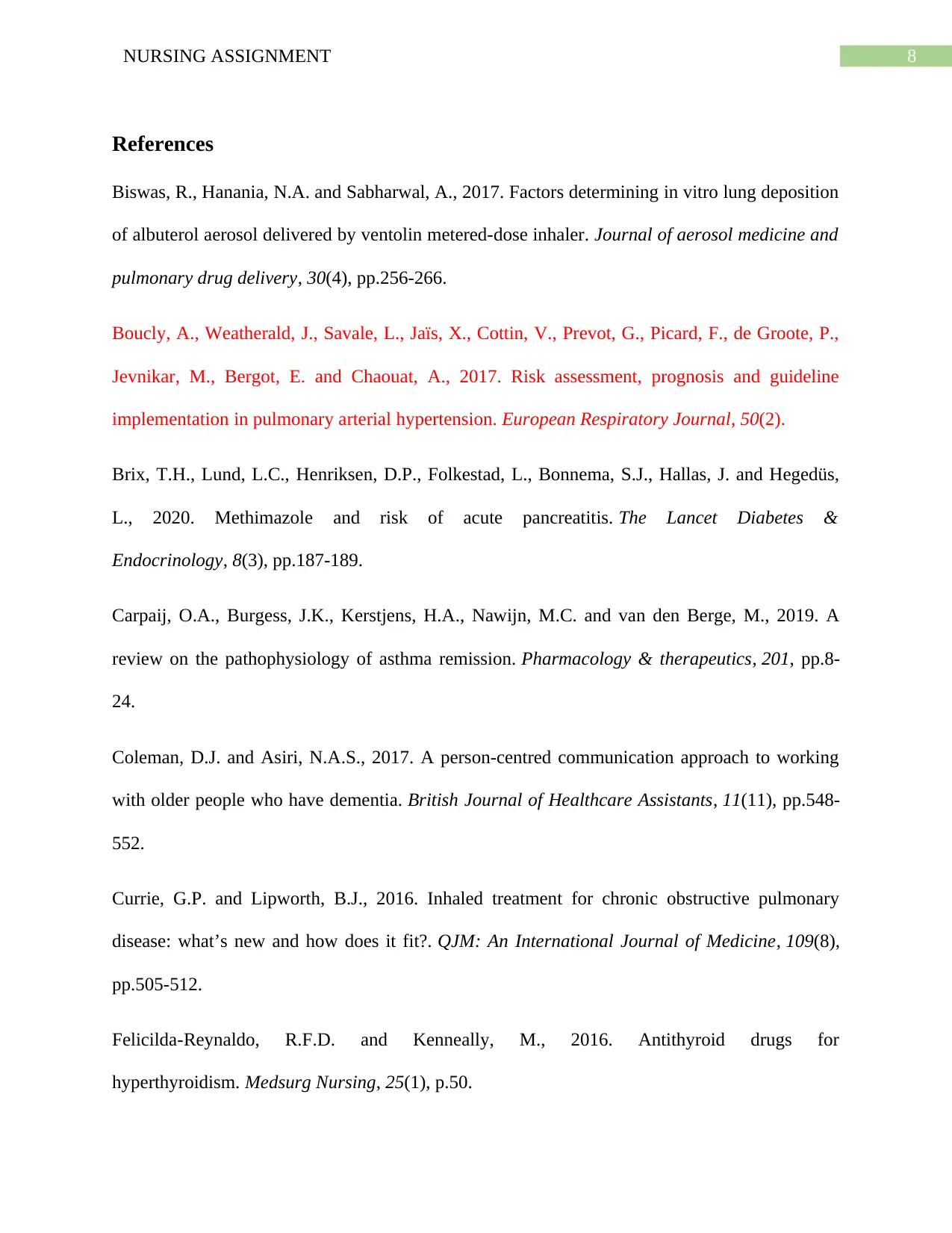
8NURSING ASSIGNMENT
References
Biswas, R., Hanania, N.A. and Sabharwal, A., 2017. Factors determining in vitro lung deposition
of albuterol aerosol delivered by ventolin metered-dose inhaler. Journal of aerosol medicine and
pulmonary drug delivery, 30(4), pp.256-266.
Boucly, A., Weatherald, J., Savale, L., Jaïs, X., Cottin, V., Prevot, G., Picard, F., de Groote, P.,
Jevnikar, M., Bergot, E. and Chaouat, A., 2017. Risk assessment, prognosis and guideline
implementation in pulmonary arterial hypertension. European Respiratory Journal, 50(2).
Brix, T.H., Lund, L.C., Henriksen, D.P., Folkestad, L., Bonnema, S.J., Hallas, J. and Hegedüs,
L., 2020. Methimazole and risk of acute pancreatitis. The Lancet Diabetes &
Endocrinology, 8(3), pp.187-189.
Carpaij, O.A., Burgess, J.K., Kerstjens, H.A., Nawijn, M.C. and van den Berge, M., 2019. A
review on the pathophysiology of asthma remission. Pharmacology & therapeutics, 201, pp.8-
24.
Coleman, D.J. and Asiri, N.A.S., 2017. A person-centred communication approach to working
with older people who have dementia. British Journal of Healthcare Assistants, 11(11), pp.548-
552.
Currie, G.P. and Lipworth, B.J., 2016. Inhaled treatment for chronic obstructive pulmonary
disease: what’s new and how does it fit?. QJM: An International Journal of Medicine, 109(8),
pp.505-512.
Felicilda-Reynaldo, R.F.D. and Kenneally, M., 2016. Antithyroid drugs for
hyperthyroidism. Medsurg Nursing, 25(1), p.50.
References
Biswas, R., Hanania, N.A. and Sabharwal, A., 2017. Factors determining in vitro lung deposition
of albuterol aerosol delivered by ventolin metered-dose inhaler. Journal of aerosol medicine and
pulmonary drug delivery, 30(4), pp.256-266.
Boucly, A., Weatherald, J., Savale, L., Jaïs, X., Cottin, V., Prevot, G., Picard, F., de Groote, P.,
Jevnikar, M., Bergot, E. and Chaouat, A., 2017. Risk assessment, prognosis and guideline
implementation in pulmonary arterial hypertension. European Respiratory Journal, 50(2).
Brix, T.H., Lund, L.C., Henriksen, D.P., Folkestad, L., Bonnema, S.J., Hallas, J. and Hegedüs,
L., 2020. Methimazole and risk of acute pancreatitis. The Lancet Diabetes &
Endocrinology, 8(3), pp.187-189.
Carpaij, O.A., Burgess, J.K., Kerstjens, H.A., Nawijn, M.C. and van den Berge, M., 2019. A
review on the pathophysiology of asthma remission. Pharmacology & therapeutics, 201, pp.8-
24.
Coleman, D.J. and Asiri, N.A.S., 2017. A person-centred communication approach to working
with older people who have dementia. British Journal of Healthcare Assistants, 11(11), pp.548-
552.
Currie, G.P. and Lipworth, B.J., 2016. Inhaled treatment for chronic obstructive pulmonary
disease: what’s new and how does it fit?. QJM: An International Journal of Medicine, 109(8),
pp.505-512.
Felicilda-Reynaldo, R.F.D. and Kenneally, M., 2016. Antithyroid drugs for
hyperthyroidism. Medsurg Nursing, 25(1), p.50.
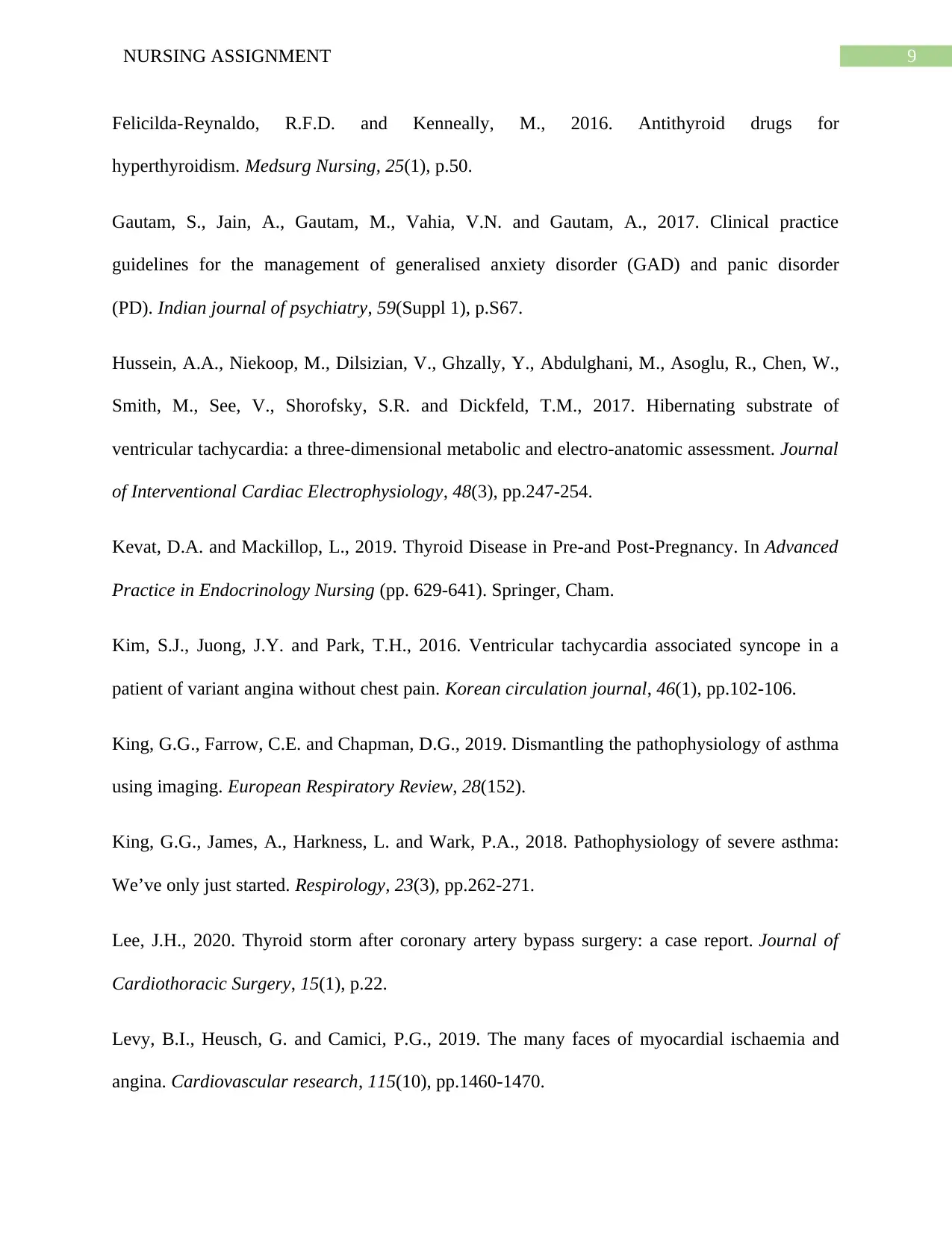
9NURSING ASSIGNMENT
Felicilda-Reynaldo, R.F.D. and Kenneally, M., 2016. Antithyroid drugs for
hyperthyroidism. Medsurg Nursing, 25(1), p.50.
Gautam, S., Jain, A., Gautam, M., Vahia, V.N. and Gautam, A., 2017. Clinical practice
guidelines for the management of generalised anxiety disorder (GAD) and panic disorder
(PD). Indian journal of psychiatry, 59(Suppl 1), p.S67.
Hussein, A.A., Niekoop, M., Dilsizian, V., Ghzally, Y., Abdulghani, M., Asoglu, R., Chen, W.,
Smith, M., See, V., Shorofsky, S.R. and Dickfeld, T.M., 2017. Hibernating substrate of
ventricular tachycardia: a three-dimensional metabolic and electro-anatomic assessment. Journal
of Interventional Cardiac Electrophysiology, 48(3), pp.247-254.
Kevat, D.A. and Mackillop, L., 2019. Thyroid Disease in Pre-and Post-Pregnancy. In Advanced
Practice in Endocrinology Nursing (pp. 629-641). Springer, Cham.
Kim, S.J., Juong, J.Y. and Park, T.H., 2016. Ventricular tachycardia associated syncope in a
patient of variant angina without chest pain. Korean circulation journal, 46(1), pp.102-106.
King, G.G., Farrow, C.E. and Chapman, D.G., 2019. Dismantling the pathophysiology of asthma
using imaging. European Respiratory Review, 28(152).
King, G.G., James, A., Harkness, L. and Wark, P.A., 2018. Pathophysiology of severe asthma:
We’ve only just started. Respirology, 23(3), pp.262-271.
Lee, J.H., 2020. Thyroid storm after coronary artery bypass surgery: a case report. Journal of
Cardiothoracic Surgery, 15(1), p.22.
Levy, B.I., Heusch, G. and Camici, P.G., 2019. The many faces of myocardial ischaemia and
angina. Cardiovascular research, 115(10), pp.1460-1470.
Felicilda-Reynaldo, R.F.D. and Kenneally, M., 2016. Antithyroid drugs for
hyperthyroidism. Medsurg Nursing, 25(1), p.50.
Gautam, S., Jain, A., Gautam, M., Vahia, V.N. and Gautam, A., 2017. Clinical practice
guidelines for the management of generalised anxiety disorder (GAD) and panic disorder
(PD). Indian journal of psychiatry, 59(Suppl 1), p.S67.
Hussein, A.A., Niekoop, M., Dilsizian, V., Ghzally, Y., Abdulghani, M., Asoglu, R., Chen, W.,
Smith, M., See, V., Shorofsky, S.R. and Dickfeld, T.M., 2017. Hibernating substrate of
ventricular tachycardia: a three-dimensional metabolic and electro-anatomic assessment. Journal
of Interventional Cardiac Electrophysiology, 48(3), pp.247-254.
Kevat, D.A. and Mackillop, L., 2019. Thyroid Disease in Pre-and Post-Pregnancy. In Advanced
Practice in Endocrinology Nursing (pp. 629-641). Springer, Cham.
Kim, S.J., Juong, J.Y. and Park, T.H., 2016. Ventricular tachycardia associated syncope in a
patient of variant angina without chest pain. Korean circulation journal, 46(1), pp.102-106.
King, G.G., Farrow, C.E. and Chapman, D.G., 2019. Dismantling the pathophysiology of asthma
using imaging. European Respiratory Review, 28(152).
King, G.G., James, A., Harkness, L. and Wark, P.A., 2018. Pathophysiology of severe asthma:
We’ve only just started. Respirology, 23(3), pp.262-271.
Lee, J.H., 2020. Thyroid storm after coronary artery bypass surgery: a case report. Journal of
Cardiothoracic Surgery, 15(1), p.22.
Levy, B.I., Heusch, G. and Camici, P.G., 2019. The many faces of myocardial ischaemia and
angina. Cardiovascular research, 115(10), pp.1460-1470.
Secure Best Marks with AI Grader
Need help grading? Try our AI Grader for instant feedback on your assignments.
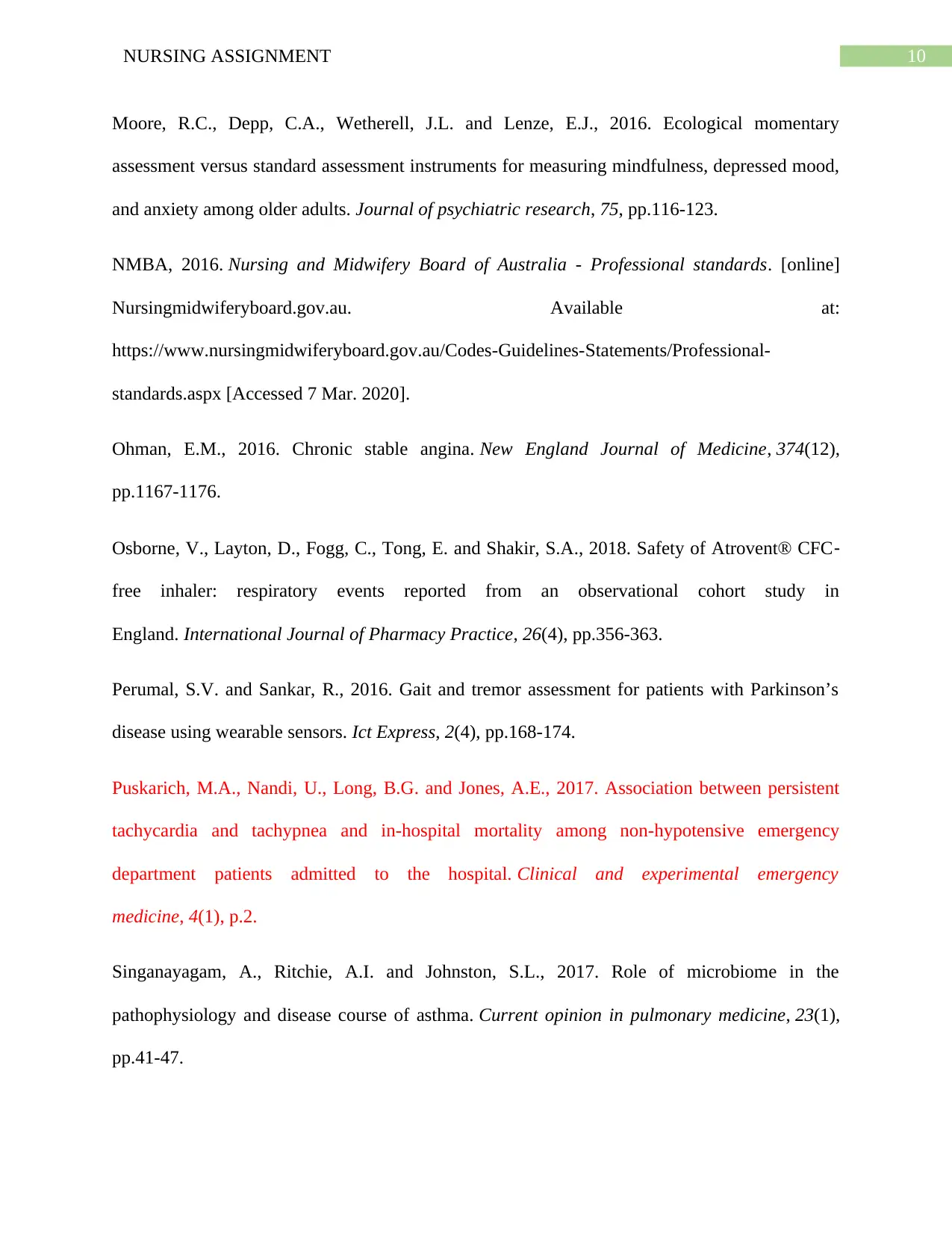
10NURSING ASSIGNMENT
Moore, R.C., Depp, C.A., Wetherell, J.L. and Lenze, E.J., 2016. Ecological momentary
assessment versus standard assessment instruments for measuring mindfulness, depressed mood,
and anxiety among older adults. Journal of psychiatric research, 75, pp.116-123.
NMBA, 2016. Nursing and Midwifery Board of Australia - Professional standards. [online]
Nursingmidwiferyboard.gov.au. Available at:
https://www.nursingmidwiferyboard.gov.au/Codes-Guidelines-Statements/Professional-
standards.aspx [Accessed 7 Mar. 2020].
Ohman, E.M., 2016. Chronic stable angina. New England Journal of Medicine, 374(12),
pp.1167-1176.
Osborne, V., Layton, D., Fogg, C., Tong, E. and Shakir, S.A., 2018. Safety of Atrovent® CFC‐
free inhaler: respiratory events reported from an observational cohort study in
England. International Journal of Pharmacy Practice, 26(4), pp.356-363.
Perumal, S.V. and Sankar, R., 2016. Gait and tremor assessment for patients with Parkinson’s
disease using wearable sensors. Ict Express, 2(4), pp.168-174.
Puskarich, M.A., Nandi, U., Long, B.G. and Jones, A.E., 2017. Association between persistent
tachycardia and tachypnea and in-hospital mortality among non-hypotensive emergency
department patients admitted to the hospital. Clinical and experimental emergency
medicine, 4(1), p.2.
Singanayagam, A., Ritchie, A.I. and Johnston, S.L., 2017. Role of microbiome in the
pathophysiology and disease course of asthma. Current opinion in pulmonary medicine, 23(1),
pp.41-47.
Moore, R.C., Depp, C.A., Wetherell, J.L. and Lenze, E.J., 2016. Ecological momentary
assessment versus standard assessment instruments for measuring mindfulness, depressed mood,
and anxiety among older adults. Journal of psychiatric research, 75, pp.116-123.
NMBA, 2016. Nursing and Midwifery Board of Australia - Professional standards. [online]
Nursingmidwiferyboard.gov.au. Available at:
https://www.nursingmidwiferyboard.gov.au/Codes-Guidelines-Statements/Professional-
standards.aspx [Accessed 7 Mar. 2020].
Ohman, E.M., 2016. Chronic stable angina. New England Journal of Medicine, 374(12),
pp.1167-1176.
Osborne, V., Layton, D., Fogg, C., Tong, E. and Shakir, S.A., 2018. Safety of Atrovent® CFC‐
free inhaler: respiratory events reported from an observational cohort study in
England. International Journal of Pharmacy Practice, 26(4), pp.356-363.
Perumal, S.V. and Sankar, R., 2016. Gait and tremor assessment for patients with Parkinson’s
disease using wearable sensors. Ict Express, 2(4), pp.168-174.
Puskarich, M.A., Nandi, U., Long, B.G. and Jones, A.E., 2017. Association between persistent
tachycardia and tachypnea and in-hospital mortality among non-hypotensive emergency
department patients admitted to the hospital. Clinical and experimental emergency
medicine, 4(1), p.2.
Singanayagam, A., Ritchie, A.I. and Johnston, S.L., 2017. Role of microbiome in the
pathophysiology and disease course of asthma. Current opinion in pulmonary medicine, 23(1),
pp.41-47.
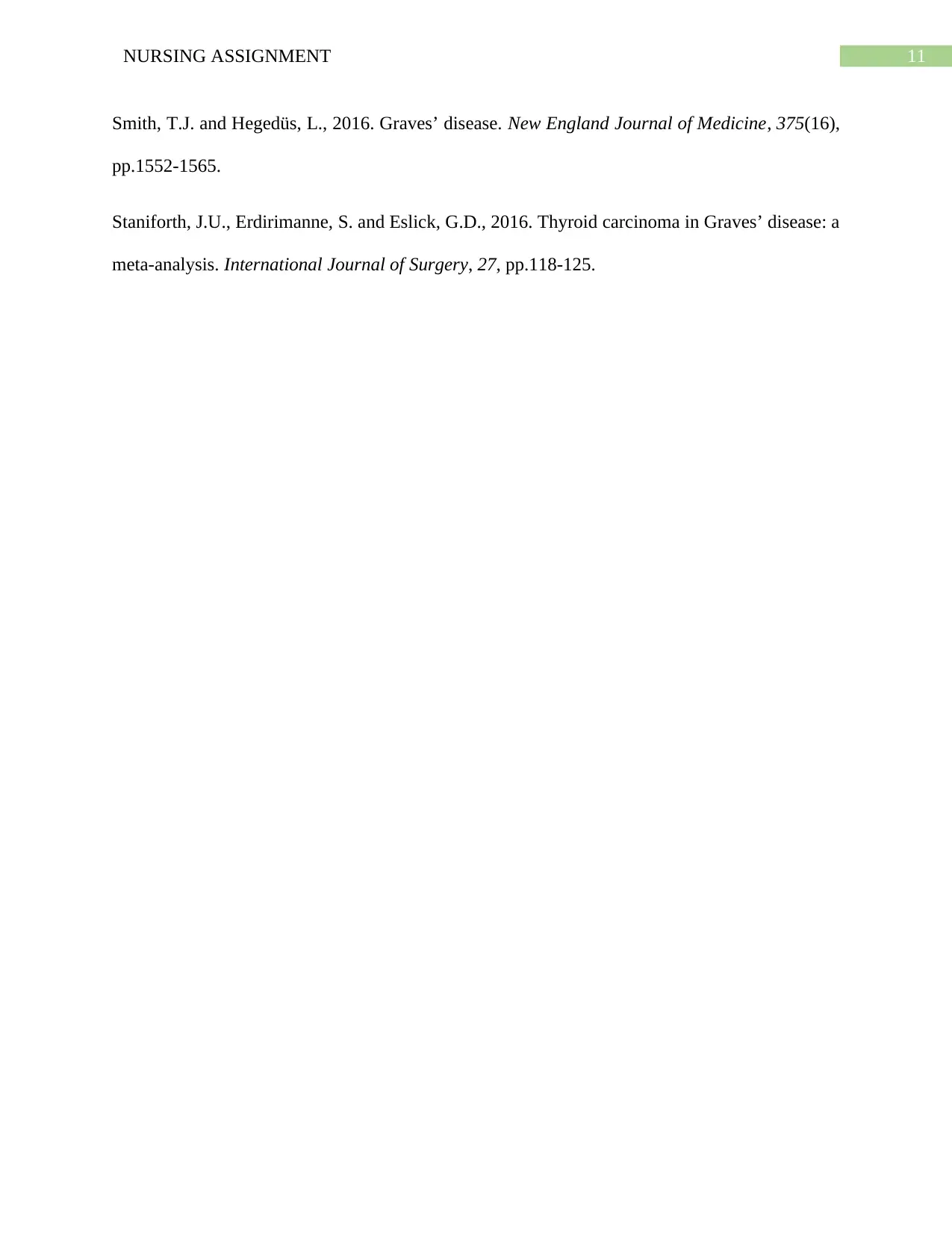
11NURSING ASSIGNMENT
Smith, T.J. and Hegedüs, L., 2016. Graves’ disease. New England Journal of Medicine, 375(16),
pp.1552-1565.
Staniforth, J.U., Erdirimanne, S. and Eslick, G.D., 2016. Thyroid carcinoma in Graves’ disease: a
meta-analysis. International Journal of Surgery, 27, pp.118-125.
Smith, T.J. and Hegedüs, L., 2016. Graves’ disease. New England Journal of Medicine, 375(16),
pp.1552-1565.
Staniforth, J.U., Erdirimanne, S. and Eslick, G.D., 2016. Thyroid carcinoma in Graves’ disease: a
meta-analysis. International Journal of Surgery, 27, pp.118-125.
1 out of 12
Related Documents
Your All-in-One AI-Powered Toolkit for Academic Success.
+13062052269
info@desklib.com
Available 24*7 on WhatsApp / Email
![[object Object]](/_next/static/media/star-bottom.7253800d.svg)
Unlock your academic potential
© 2024 | Zucol Services PVT LTD | All rights reserved.





